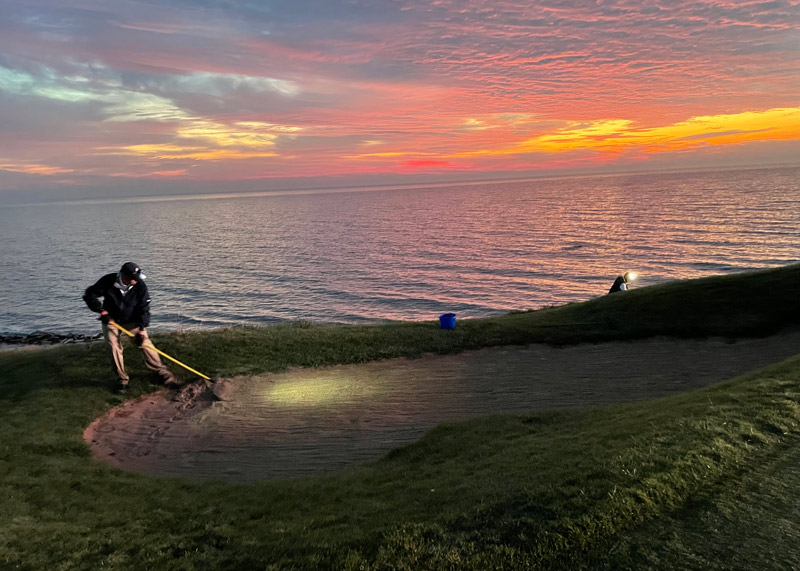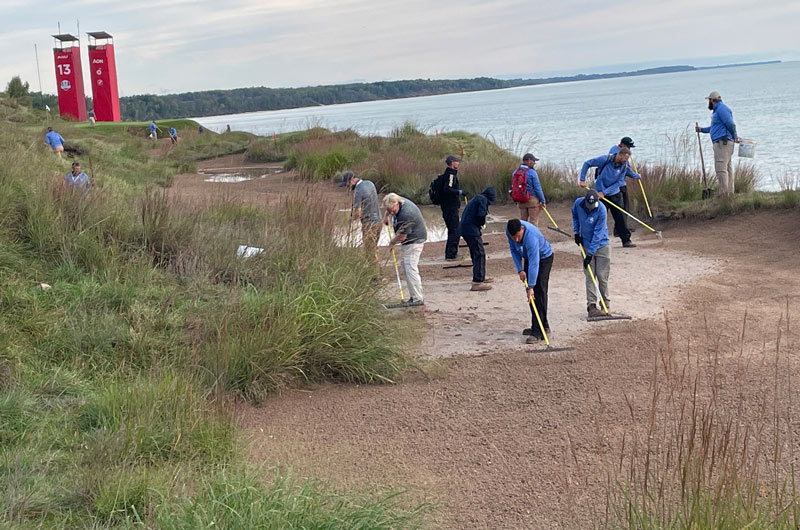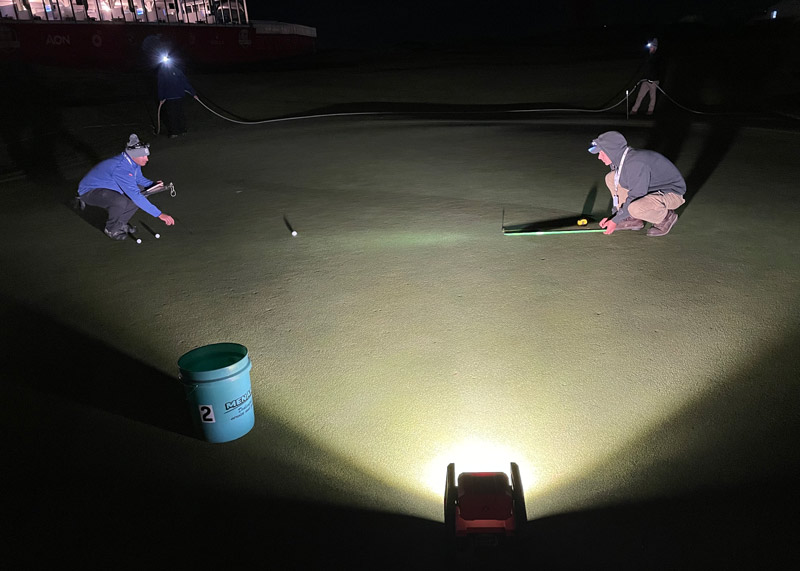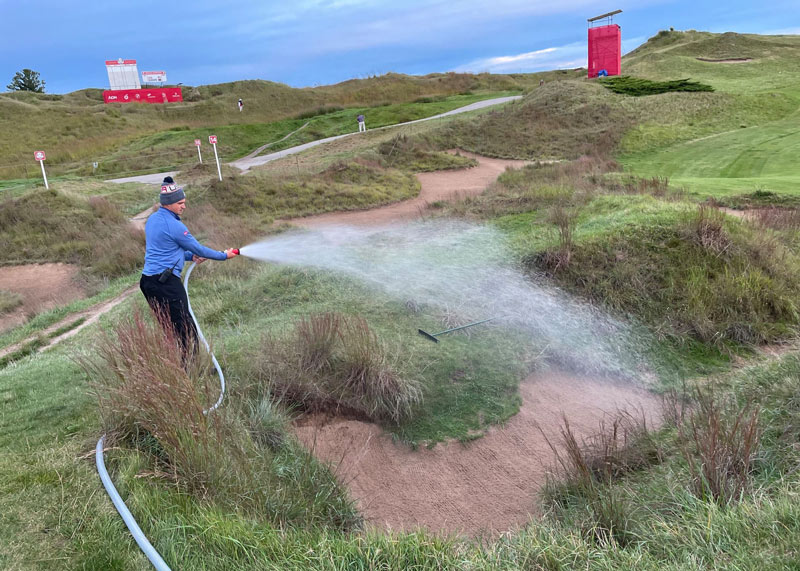
The 18th hole on the Straits Course at Whistling Straits, pictured on Monday, Sept. 20, from directly behind the green. The ninth green is just to the right. The Straits Course is hosting the Ryder Cup’s 43rd playing one year later than it was originally slated, postponed because of the coronavirus pandemic. Photo by Scott Hollister
The Straits Course: Fast facts
The 2021 Ryder Cup will be held Sept. 24-26 on the Straits Course at Whistling Straits in Kohler, Wis.
The grass
Greens: Creeping bentgrass maintained at .100 inch
Tees: Creeping bentgrass maintained at .312 inch
Fairways: Fescue/creeping bentgrass/Poa annua maintained at .400 inch
Rough: Fine fescue maintained at 2.5 to 4 inches
The course
Year built: 1998
Architect: Pete Dye
Average green size: 7,000 square feet
Acres of fairway: 23
Acres of rough: 200-plus
Number of sand bunkers: “more than 1,000” (read more in Tuesday’s dispatch, below)
Number of water hazards: 3
Number of holes on which water is in play: 1
Soil conditions: Mixed
Water sources: Well
Par: 36-35—71
Yardage: 7,355
- A flock of Scottish Blackface sheep roams the property, just as one might encounter on a country course in the British Isles.
- The property once served as an airfield, part of a U.S. Army anti-aircraft training range, from 1949 to 1959.
- The golf course stretches nearly 2 miles along the shores of Lake Michigan.
The staff

The maintenance leadership team on the Straits Course at Whistling Straits (from left): superintendent Jeff Wilson; assistant superintendent Casey Blindauer; director of golf course maintenance Chris Zugel, CGCS; assistant superintendent Brandon Schegetz; and assistant superintendent Tyler Chaloupka. Photo by Ben Wick/EPIC Creative
Chris Zugel, CGCS, director of golf course maintenance
Jeff Wilson, Straits Course superintendent
Casey Blindauer, assistant superintendent
Brandon Schegetz, assistant superintendent
Tyler Chaloupka, assistant superintendent
Clifford Henning, equipment manager
Mike O’Reilly, PGA professional
Number of employees: 42
Number of tournament volunteers: 60
Dispatches from the Ryder Cup
GCM Editor-in-Chief Scott Hollister has been on-site at Whistling Straits since Sunday, chronicling the work of director of golf course maintenance Chris Zugel, CGCS, and his team in the lead-up to the U.S. vs. Europe showdown. Read his reports below.
Monday, Sept. 20, 2021
Everyone deserves a practice round before a major championship. That includes the 100-plus members of the maintenance team readying the Straits Course at Whistling Straits for this week’s 43rd playing of the Ryder Cup.
That’s exactly what they got Monday. The course was closed for play, so only a handful of competitors for the U.S. and European teams even stepped foot on the property. Aside from security personnel, folks with the event’s various international broadcast partners and construction workers finishing up last-minute projects, Chris Zugel and company had the place to themselves.
And Zugel, the golf course maintenance director for the Kohler Co., admitted they needed the practice. Not because the turfgrass professionals gathered here didn’t have vast experience in tournament prep or in running their own golf facilities to draw upon.
But for the full-time staff at Whistling Straits, a limited-field, match-play event like the Ryder Cup is a different animal from the many PGA Championships that have been contested there. And for the volunteers spending a week in northeastern Wisconsin, navigating a property as unique as Whistling Straits takes some getting used to, even without the massive infrastructure that has grown up around the course and blocked many natural paths of travel throughout the layout.
“We know how to do PGA Championships. It’s pretty much the same every day of tournament week,” Zugel told the team prior to early morning rounds. “This week, things could change every day. We might have to be a little flexible as we go along.”
That played out on Monday. For the most part, morning work went off with few hitches aside from the occasional clarification and question from workers.

Raking a greenside bunker on No. 16. Photos by Scott Hollister

Volunteer Conrad Pannkuk, assistant superintendent at Hallbrook Country Club in Leawood, Kan., takes green speed measurements on the 16th green.

The “Pro Greens” teams getting instructions on the preferred method of taking green speed measurements.
Rain showers moved in around the lunch hour, putting the limited afternoon maintenance that had been planned into an on-again, off-again holding pattern. Shortly before 2 p.m., fairways units finally rolled out to give the course the first of only two cuts fairways will receive before the weekend.
Tomorrow, though, practice is over. Crews will get a full taste of the routine they will follow for the remainder of the week, spectators will finally be allowed on property, and practice rounds for the two teams will commence.
The maintenance team at Whistling Straits will be one step ahead of them and appear ready for a big week along the shores of Lake Michigan.
Tuesday, Sept. 21, 2021
The exact number of bunkers on the Straits Course at Whistling Straits has been the subject of much conjecture and speculation since the course opened in 1998.
Most prefer to deal in generalities when the question arises, with the consensus answer seeming to be “more than 1,000.” For someone like Ron Whitten, the longtime Golf Digest architecture editor, the devil is in the details, so he famously tried to count the bunkers by hand several years back. He came up with 967.
In reality, settling on an exact number is like trying to hit a moving target. Golf courses are living, breathing natural features, and what once may have been considered only a small sandy patch hidden amidst stands of billowing fescues may have evolved into a small bunker over time, altered by time, wind and weather. And if they’re being honest, the actual number doesn’t matter all that much to the team responsible for the care and maintenance of those bunkers. All that matters is that there are a lot of them.
That point of view came into particular focus on Tuesday of Ryder Cup Week. An overnight line of storms dumped 9/10 of an inch of rain on the property, meaning bunker cleanup was job one for the maintenance team this morning. And whether that meant there were 967 bunkers to worry about or well over 1,000, they knew they had their work cut out for them.
“We did some work yesterday afternoon knowing that if it did rain, we’d have that stuff out of the way and could free up people to help with bunkers,” says Chris Zugel, director of golf course maintenance at Whistling Straits. “Unfortunately, it did rain and we got a little more than we anticipated. We had plans in place, the right kind of equipment and tools staged, but it’s still a lot of work to deal with.”


The par-4 13th hole (pictured above) provides a good snapshot of what crews had to deal with course-wide on Tuesday. The hole sits hard along the shores of Lake Michigan, with a series of long bunkers running down the right side of the hole, separating the lake from the elevated fairway. At one point, no less than 15 workers — nearly 1/5th of the entire crew on hand this week — were tackling clean-up duties on those bunkers, using pumps, buckets, shovels and all manner of rakes to shrink several large areas of standing water and freshen up the bunker as best they could.
During the playing of this year’s PGA Championship on the Ocean Course at Kiawah Island, the bunkers there were designated as “sandy areas” by rules officials, meaning that players could ground their clubs and, most importantly, that maintenance could be kept to a bare minimum.
Considering both layouts are Pete Dye designs and the bunkers at Whistling Straits are even more rustic than those on the Ocean Course, was a similar move contemplated for this week’s Ryder Cup? Zugel says it wasn’t, mainly as a nod to the course’s championship pedigree.
“Historically, they’ve been played as bunkers in all the other championships we’ve hosted,” he says. “If it looked like a bunker, we were going to maintain it as a bunker. So that history kind of dictated how we were going to treat them for the Ryder Cup. That was the standard that they set.”
A day of steady wind and spotty sunshine and another round of work during afternoon maintenance did wonders for the course’s bunkers. For the most part, all 967 (or much more than that, depending on your perspective) were back to where they had started by day’s end. And with only one more chance of rain in the forecast this week, on Thursday, hopes are crews won’t have to deal with bunker battles like the ones they faced this morning for the remainder of Ryder Cup Week.
Wednesday, Sept. 22, 2021
At Whistling Straits, they’re taking an if-it-ain’t-broke, don’t-fix-it approach to putting greens management for this week’s Ryder Cup.
The maintenance team is using a concept it calls “Pro Greens,” in which 10 teams evenly split mowing, rolling and Stimpmeter-measurement duties on the Straits Course putting surfaces (including practice greens). The concept is similar to one first employed when the course played host to the 2005 PGA Championship and has been repeated and refined in its other major championship turns — the 2007 U.S. Senior Open, and the 2010 and 2015 PGAs.
To be fair, what’s being done here isn’t all that different from what other courses hosting major championships have done when it comes to greens maintenance. It’s just been taken up three or four notches by the team at Whistling Straits, with a reliance on data collection and advanced technology seldom seen in major championship golf.
Each team is made up of five workers — two who mow greens, one who rolls and two others who take Stimpmeter readings. These teams are looking after the same greens every day, which will give them an intimate understanding of the conditions of those putting surfaces by the time the weekend rolls around.
Like most other venues, those Stimpmeter readings help guide day-to-day decisions on mowing and rolling frequency. But unlike most others, Whistling Straits can add a treasure trove of historical data from previous championships to the decision-making equation. Jimmy Leibham, an assistant superintendent on the Irish Course who is overseeing these efforts this week, says the team has access to spreadsheets dating back to those very first tournaments, which means if you wanted to know the condition of the 14th green on Thursday of the 2010 PGA and what decisions were made based on that information, you could.


A cold wind greeted the maintenance team at Whistling Straits on Wednesday, particularly on lakeside holes like No. 17.

Just 24 hours after many bunkers had standing water following storms that rolled through Whistling Straits, stiff winds off Lake Michigan had dried out some of those same bunkers, requiring a light watering to maintain the proper consistency.

Straits Course superintendent Jeff Wilson (left) and crew member Matt Hill study an irrigation map while parked near the fifth green. With all the additional machinery around the course, the maintenance team is dealing with isolated cases of issues like broken irrigation heads.
Monday of Ryder Cup week served largely as a dress rehearsal for the Pro Greens teams, a chance to walk-through the duties, familiarize themselves with the putting surfaces they’d be caring for all week and map the best routes around the golf course to reach those greens, a task complicated by the massive build-out for the Ryder Cup.
Starting Tuesday, those tasks became more involved. Greens were mowed and rolled, then Stimpmeter readings were taken. Based on those results and their relation to the targets that had been set before the week, additional cuts and rolls could be employed to get closer to “championship speed.”
And if Wednesday is any indication of how the rest of the week will play out, Whistling Straits’ adherence to this kind of precision turfgrass management will come in handy. The summer-like conditions that were here when volunteers arrived on Sunday gave way to the first real taste of fall in this part of the world. Morning temperatures were in the upper 40s with a brisk wind blowing in off Lake Michigan.
That meant greens that only 24 hours earlier had taken nearly an inch of rain were quickly drying out and speeding up. Especially for those holes right along the lake, the work being done by the Pro Greens teams will be crucial in keeping green speeds at a manageable level and ensuring a successful event once play begins on Friday.
— Scott Hollister, GCM editor-in-chief
Volunteering at the 2021 Ryder Cup
Members of the volunteer workforce who’ve helped get Whistling Straits in top form this week reflect on the experience:
Straits talk
As a Wisconsin native, U.S. Ryder Cup captain Steve Stricker is well versed in the state. But when it comes to Whistling Straits, he welcomed learning more about the maintenance side of it from Chris Zugel, CGCS.
“You get a lot of questions in this industry about what we do and things like that. Sometimes you don’t necessarily know where they’re coming from, but he had an interest in what we did, wanted to know things I wouldn’t think he’d be interested,” Zugel says. “This spring we were talking about irrigation systems and going over the nuts and bolts of golf courses. He was looking to what the makeup of the golf course is, the ins and outs of it. He had a great interest in golf course maintenance. He listened intently, and he was very genuine in his questions, so it was pretty cool.”
Whistling Straits, part of a U.S. Army anti-aircraft training range from 1949 to ’59, has changed just a bit since it hosted the 2015 PGA Championship in which Stricker tied for 30th. The bunkers, though, still are there. How many are there? “I like to say around 1,000. They come and go. They won’t all come into play,” Zugel says. “Some have expanded over time, some will connect, and they’re definitely an organic feature that can change. Some stay where they are. Some, the edges may be a little different with the wind in the winter and moving the sand around. They’re kind of like an amoeba. They grow and twist and spread and shrink. But there’s a few of them out there.”
There are a few noticeable changes since 2015 — wider fairways at the par-4 ninth and par-5 11th and additional greenside rough at Nos. 2, 5 and 9 on the front. As far as the fairways, Zugel says, “We changed a couple mow lines here and there. Nothing dramatic. Over the years, the fairways had gotten somewhat smaller.”
A late-September event of this enormity is a key difference from the PGA Championship, which six years ago happened in August. That means Whistling Straits will be open for play a month longer than usual before it closes one week prior to the Ryder Cup. “It’s a challenge because of the amount of play that we get, so it’s about making sure things are holding in there,” Zugel says. “September in Wisconsin is typically a very nice time. Little drier, really start to get color difference between fescue mounds and the fairways, so the course looks great at that time of the year. All the people you’re going to get there on a beautiful fall day for the Ryder Cup is going to be great.”
— Howard Richman, GCM associate editor